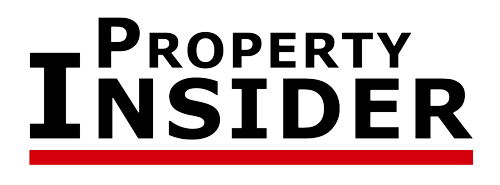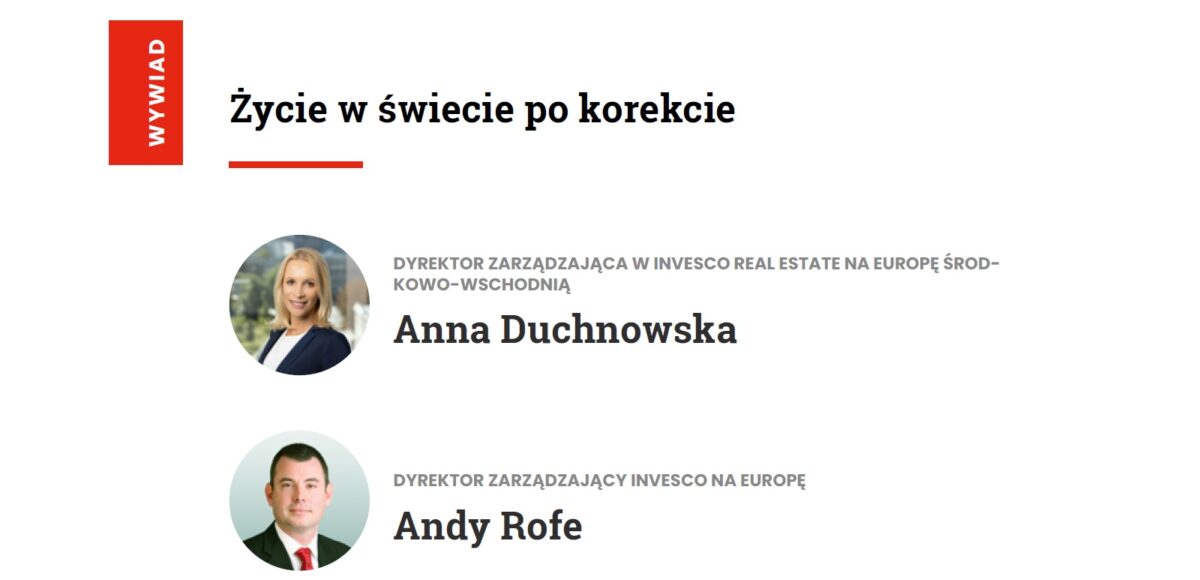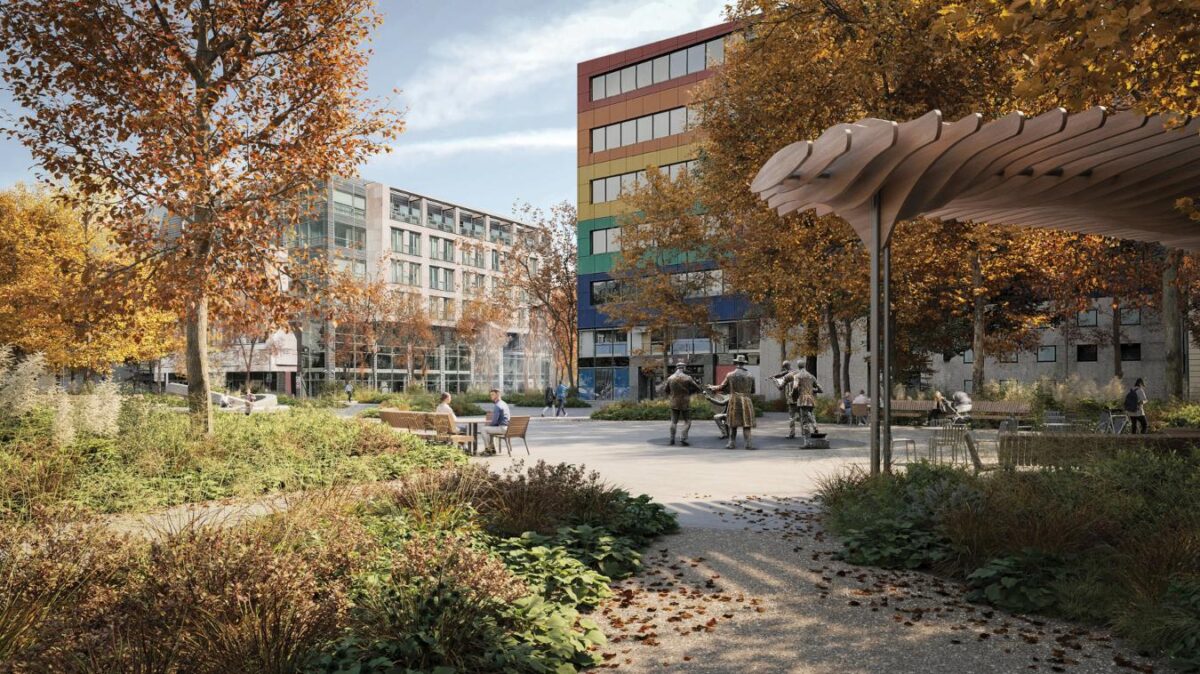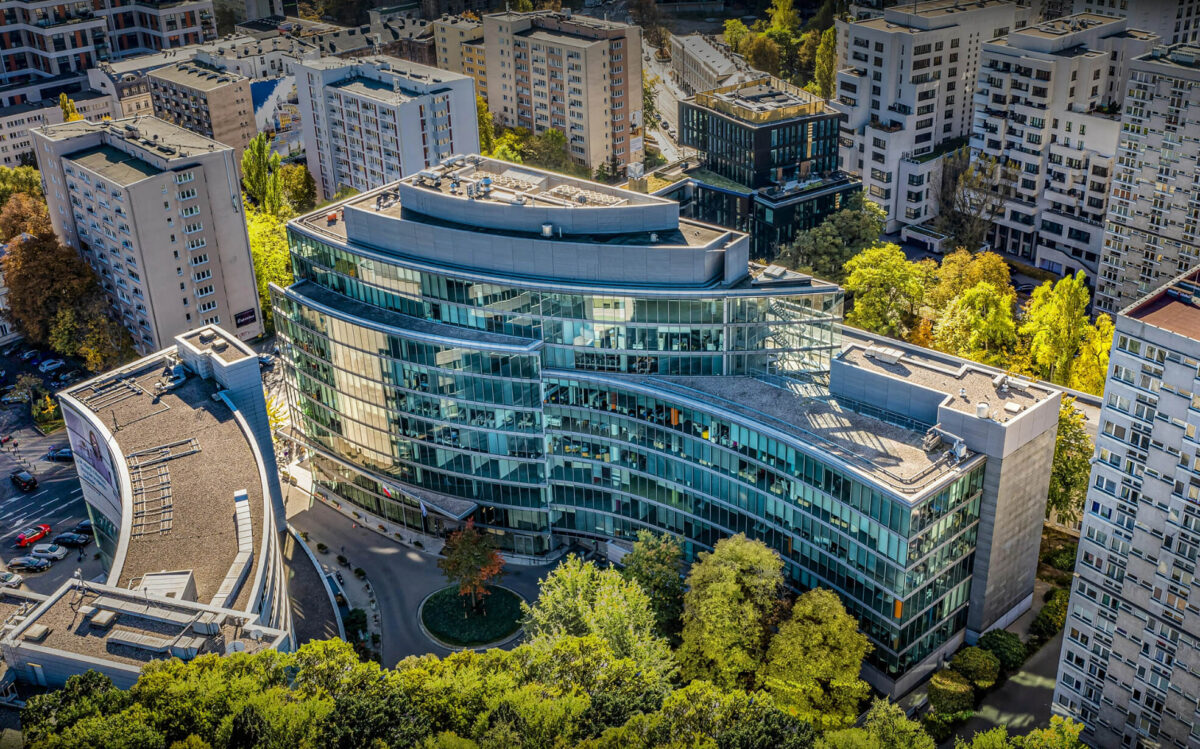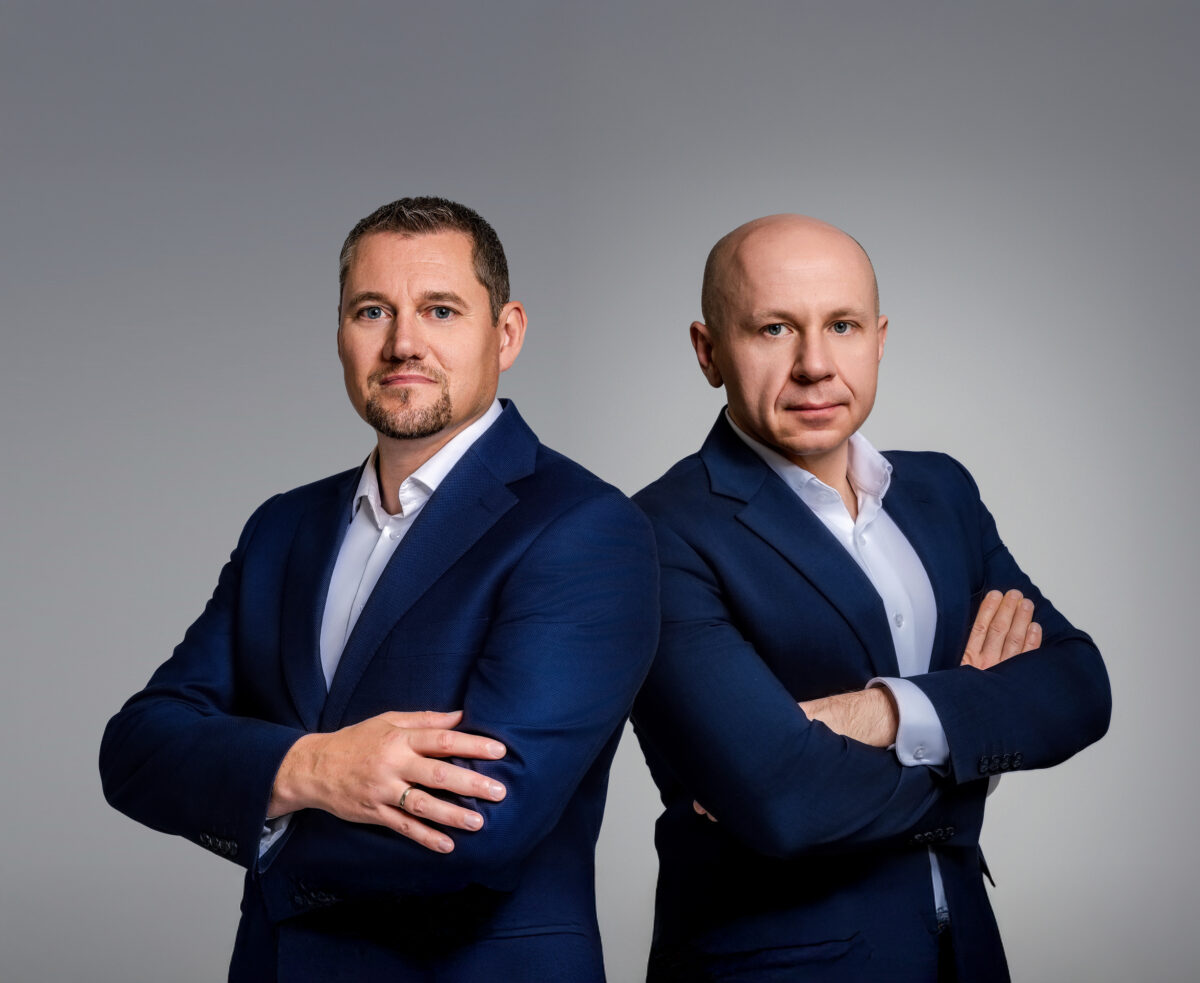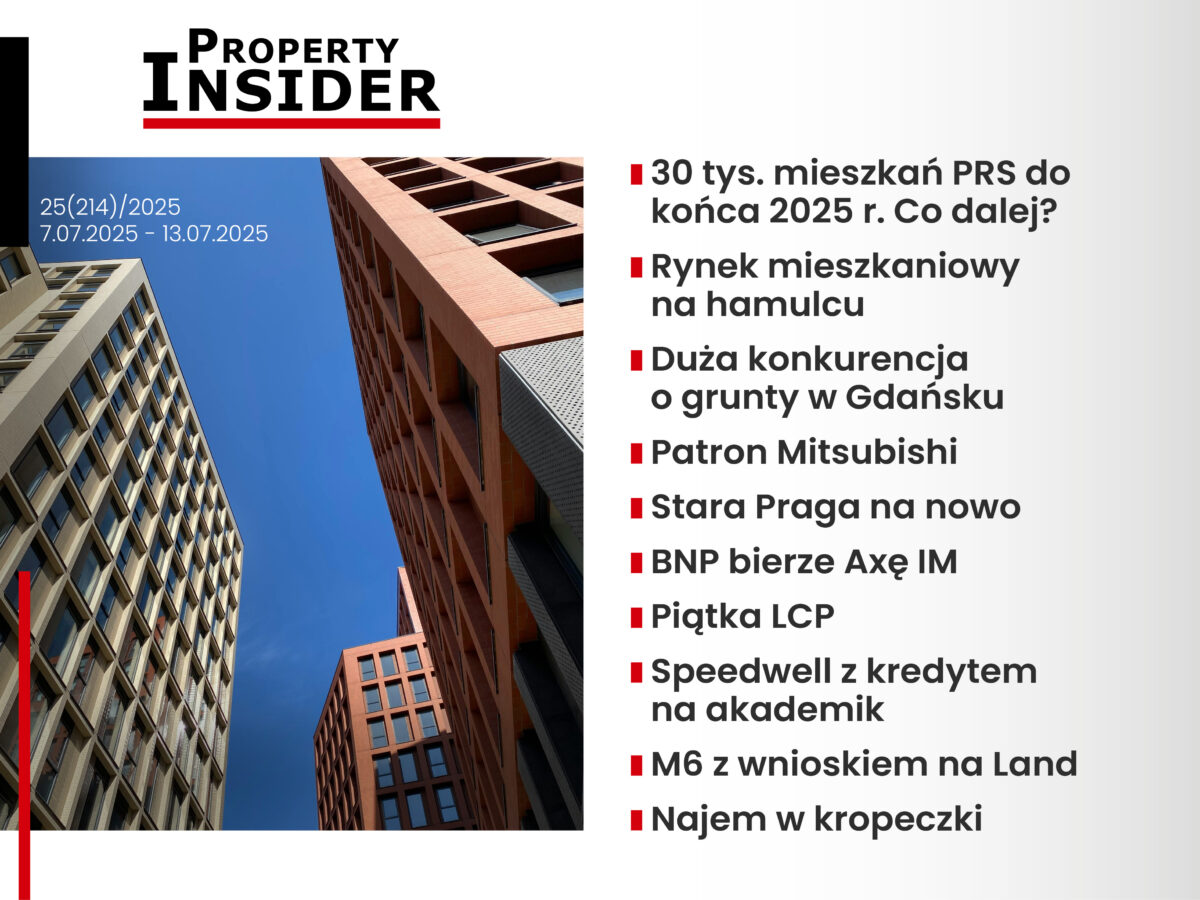Invesco Real Estate zainwestowało około 2,6 mld euro w całej Europie i planuje kolejne inwestycje. Rozmawiamy z Andym Rofe, dyrektorem zarządzającym Invesco na Europę, oraz Anną Duchnowską, dyrektor zarządzającą w Invesco Real Estate na Europę Środkowo-Wschodnią, aby dowiedzieć się, dlaczego region, pomimo wojny na Ukrainie, przyciąga inwestorów, a Polska może oczekiwać wzrostu obrotu inwestycyjnego w 2025 r.
„Property Insider”: Jaka jest obecna sytuacja na rynku inwestycyjnym w Polsce i Europie?
Andy Rofe: Od czerwca 2022 r. Europa jako region doświadczała korekty cen, średnia obniżka wartości aktywów była w granicach 20–25 proc. Europa na te korektę zareagowała wcześniej niż inne kontynenty. W poprzednich cyklach to Stany Zjednoczone były pierwsze. Tym razem impulsem była inwazja Rosji na Ukrainę w lutym 2022 r., co przyspieszyło zmianę nastrojów i zapoczątkowało korektę w czerwcu 2022 r., podczas gdy w USA nastąpiło to około sześciu miesięcy później. W Europie Zachodniej korekta zakończyła się mniej więcej w połowie tego roku. Jako Invesco Real Estate w 2024 r. ulokowaliśmy trzykrotnie więcej kapitału na rynku europejskim niż w 2023 r. Jeśli chodzi o Europę Środkową i Polskę, jesteśmy zainteresowani inwestowaniem w tym regionie i aktywnie szukamy okazji.
Anna Duchnowska: W tym roku przeprowadziliśmy naszą pierwszą transakcję kredytową i liczymy na kolejne. W naszym regionie, z uwagi na mniejszą płynność, dostosowanie cen przebiegało wolniej niż w Europie Zachodniej. Brakowało transakcji, które pokazałyby rynkowi, jakie są rzeczywiste ceny i stopy zwrotu. W tym roku pojawił się jednak większy ruch, w tym transakcja dużej wieży biurowej w Warszawie za prawie 300 mln euro. Myślę, że przyszły rok będzie lepszy, ponieważ kupujący i sprzedający znajdą wspólny mianownik przy zawieraniu transakcji.
Rynek inwestycyjny się zmienia, ale co będzie głównym motorem dla inwestorów w 2025 r.?
Anna Duchnowska: Już teraz widzimy zmianę struktury inwestorów w regionie, co jest naturalne w czasach niepewności i zmienności rynkowej. W takich sytuacjach inwestorzy zwykle wracają na swoje rynki krajowe. Oczekuję, że w Polsce pojawi się więcej lokalnego kapitału instytucjonalnego, którego obecnie brakuje. Gdy rynek się ustabilizuje i ceny wzrosną, napływ kapitału zagranicznego również wzrośnie. Jestem optymistycznie nastawiona. Może rok 2025 nie przyniesie spektakularnego wolumenu transakcji, ale inwestycje będą stopniowo rosły wraz z obniżaniem stóp procentowych.
Czy wojna na Ukrainie stanowi ryzyko dla inwestorów w Polsce?
Andy Rofe: To kwestia całego regionu – całej Europy. Wojna w jakiejkolwiek części regionu – Europy czy Bliskiego Wschodu – zniechęca inwestorów globalnych, i to nie jest kwestia jedynie Polski. Jeśli ktoś akceptuje takie ryzyko geopolityczne, analizuje każdy rynek indywidualnie.
Jakie sektory są obecnie najbardziej atrakcyjne?
Andy Rofe: Nasze inwestycje koncentrują się na logistyce i sektorze mieszkaniowym obejmującym akademiki, hotele i PRS (sektor mieszkań na wynajem). Te dwa sektory stanowią po 50 proc. naszej aktywności inwestycyjnej.
Anna Duchnowska: W Polsce nie zrealizowaliśmy jeszcze żadnej transakcji w sektorze PRS ani akademików. W Czechach udało nam się jedną, a aktywo działa i przynosi dobre wyniki. Polski instytucjonalny rynek mieszkań na wynajem jest nadal niedojrzały. Istnieje wiele możliwości, ale mało jest transakcji na poziomie instytucjonalnym, a to jest kluczowe, aby udowodnić potencjał tego sektora.
Planujecie kupować lub sprzedawać coś w Polsce?
Anna Duchnowska: Zdecydowanie. Nasza strategia zawsze obejmuje sprzedaż. Mocno inwestujemy w logistykę i niemal co roku coś kupujemy lub sprzedajemy. Cieszę się z naszej ostatniej transakcji hotelowej w Gdańsku, gdzie nabyliśmy Hotel Cloud One z 327 pokojami . To pokazuje, że jesteśmy stabilnym, długofalowym inwestorem, który na polskim rynku jest w stanie znaleźć ciekawe propozycje inwestycyjne.
Andy Rofe: Jesteśmy jednym z najbardziej aktywnych inwestorów w Europie, z transakcjami na poziomie wyższym od średniej rynkowej. Uważamy, że trzeba realizować założone plany biznesowe i sukcesywnie sprzedawać aktywa, by materializować zyski dla naszych inwestorów.
Co z Q22 – planujecie go jeszcze zatrzymać czy sprzedać?
Anna Duchnowska: Nasza filozofia inwestycyjna zakłada sprzedaż każdego aktywa w przyszłości, tak budujemy nasze modele inwestycyjne. Jesteśmy zadowoleni z Q22 – gdzie praktycznie wszyscy najemcy przedłużyli swoje umowy, i to często na wyższych czynszach. Budynek jest w pełni wynajęty. Aktywnie utrzymujemy ten biurowiec na najwyższym poziomie właśnie po to, aby nasi najemcy byli zadowoleni i z przyjemnością chodzili do biura.
Jakie środki zamierzacie przeznaczyć na inwestycje w Europie w przyszłym roku?
Andy Rofe: W tym roku przeprowadziliśmy transakcje o wartości około 2,6 mld euro w całej Europie i myślę, że w przyszłym roku kwota ta będzie podobna. To najwyższy poziom inwestycji w ciągu ostatnich pięciu lat.
Logistyka po pandemii COVID-19 rozwijała się dynamicznie, ale w ciągu ostatniego półtora roku spowolniła. Czy w 2025 r. nadal będzie atrakcyjnym sektorem?
Anna Duchnowska: Polska dysponuje wykwalifikowaną siłą roboczą, tańszą o około 30 proc. niż w Niemczech, co zawsze przyciągało inwestorów. Po pandemii przesunęliśmy się z modelu „just in time” na „just in case”, co zwiększyło znaczenie logistyki w naszym regionie. Rozwój e-commerce napędzał sektor, popyt znacząco wzrósł, a co za tym idzie, nastąpił wzrost czynszów , ale na dłuższą metę oczywiście było to nie do końca racjonalne. Obecnie rynek się ustabilizował. Nadal będzie atrakcyjny, ale wymaga przemyślanego podejścia, doświadczenia i selektywności.
Andy Rofe: W całej Europie nadal występuje nierównowaga między podażą a popytem. Ceny gruntów spadły po korekcie, co umożliwia bardziej opłacalne inwestycje.
Brak kapitału krajowego to duży problem dla polskiego rynku. W tym roku jego udział wynosi 10–15 proc., co jest dużym wzrostem w porównaniu z wcześniej obserwowanymi śladowymi poziomami. Czy REIT-y mogą być rozwiązaniem?
Anna Duchnowska: Brak polskiego kapitału instytucjonalnego to kwestia historyczna. Nigdy go nie mieliśmy. Nie wprowadzono odpowiednich ram instytucjonalnych, takich jak REIT-y czy inne pojazdy inwestycyjne. Dyskutujemy o REIT-ach od lat, ich wprowadzenie na pewno byłoby pozytywne dla rynku kapitałowego i zapewniłoby większą płynność, Niemniej to wszystko zależy od obecnych ustawodawców, którzy, aby formuła REIT-ów zadziałała, musieliby wprowadzić proste, jasne rozwiązania, a także solidne zachęty podatkowe, aby zarówno duże instytucje, jak i indywidualni inwestorzy zdecydowali się rozważyć takie inwestycje.
Wywiad ukazał się w roczniku Trendy 2025 opublikowanym 16 grudnia 2024 r.
English version below

Living in a post correction world
Invesco Real Estate, the EUR 80bn global real estate investment business of Invesco Ltd. (NYSE: IVZ), has invested around EUR 2.6 bln across Europe this year and I look forward to continuing the journey in the CEE market. We chat with Andy Rofe, Managing Director, Head of Europe at Invesco Real Estate, and Anna Duchnowska, Managing Director – Investments CEE at Invesco Real Estate to find out why the region looks attractive despite the war in Ukraine and why Poland in particular might expect an even higher investment volume in 2025.
Property Insider: Where are we now with the investment market both in Poland and in Europe?
Andy Rofe: In terms of Europe overall as a region, it’s seen a pricing correction since June 2022 that has reduced asset values by between 20-25 pct on average. Europe corrected before any other region. in the past it used to be US that leading every cycle. This time the trigger in Europe was the invasion in Ukraine in February 2022. This accelerated the sentiment change which then started an economic correction in June 2022 with energy pricing spike and inflationary pressure, while in the US, it was about six months later. In Europe, this price decrease was largely over by the middle of this year. At Invesco Real Estate, we have been very active in 2024 , we’ve put three or maybe four times as much capital into the market in 2024 than we did in 2023. Now if you translate that to the central European and Polish markets, I think there is appetite to invest in the region and we are actively looking at opportunities to put more capital into the market.
Anna Duchnowska: Well, just as an example we have done our first credit deal this year and hopefully we will be doing more. What I can say about the region is that we may have less liquidity and the pace of the pricing adjustment was slower than in Western Europe. So we have been lagging behind a bit due to the fact that there were not so many transactions to provide market evidence and understand where the pricing has really been. This year, particularly 2nd half, we are seeing momentum with quite a number of transactions happening including a huge office tower in Warsaw that changed the owner couple of weeks ago for a price in the range of EUR 280 mln. This has been the largest office deal in Continental Europe this year, so pretty impressive. My strong belief is that next year shall be better because more willing buyers and sellers will be able to find an acceptable levelto agree on a transaction.
As you say the investment market is changing but what do you think the main driver will be for investors next year in 2025?
Anna Duchnowska: We have already seen a change in the type of investor in the CEE region. This is natural that investors tend to go back to their domestic market , whenever there is any nervousness and volatility. Having said so , one would expect to see Polish institutional capital stepping in, however Poland lacks that source of capital. Once the market stabilises and the pricing becomes more expensive in Western Europe, we shall definitely see more foreign investors coming into the region looking for attractive opportunities. I am quite optimistic going forward. Maybe 2025 will not see a massive amount of money but it should gradually increase due to the fact that interest rates are coming down and real estate as asset class becomes attractive again.
Does the war in Ukraine pose a risk to those investing in Poland?
Andy Rofe: I think this is a regional issue. If parts of a region are at war be it in Europe or the middle east, that deters investors. This does affect global capital and this is not something specific to Poland only. If you are comfortable with such geopolitical risks, then you look at each market on its merits.
What are the most attractive sectors right now?
If you look at our activity we have almost exclusively invested in logistics and the living sectors, which for us includes student housing, hotels and PRS. That is more or less fifty fifty split in terms of our investment activity this year in Europe.
Anna Duchnowska: We have been very active in logistic sector for years. We haven’t done any PRS or student housing yet in Poland. However, we have done one deal in the Czech Republic and now the asset is in lease up phase with the expectation of a very good performance. I think the living market in Poland has a great potential due to structural supply gap. At the same time it is still immature. There are a lot of investment opportunities but we need more transactions at the institutional level to confirm the resilience of that new sector.
Are you planning to buy or sell something in Poland?
Anna Duchnowska: Definitely, we always have a selling strategy. If you look at our logistics portfolio we have invested heavily in CEE. And pretty much every year we have been buying or selling something.
Andy Rofe: What you have to understand, is that we are one of the most active investors. Our European transaction levels in 2024, both buying and selling are generally higher than the market average in Europe. We believe in executing on business plans, optimizing performance and have a robust system in place to then sell the asset to crystalize the performance.
What about Q22 are you going to keep it or sell it?
Anna Duchnowska: Our investment philosophy is that every asset will be sold in the future, that is how we underwrite each and every business plan. So far we are very happy with Q22. It has gone through the lease renewal cycle. It is fully occupied. The tenants have accepted the higher rent which were in line with the inflationary and rental pressure. We have invested in the building, recently opened a brand new Conference lounge Aora
Could you tell me how much you intend to spend in Europe next year?
Andy Rofe: Our overall transaction volume this year has been about EUR 2.6 bln across Europe and I would be surprised if it were any less than that figure next year. That is the highest volume that we have done in the last five years and I expect that pace of investment to continue.
Logistics improved greatly after Covid but it has now slowed down over the past year and a half. Do you still think it will be a good sector to invest in in 2025?
Anna Duchnowska: Poland has a pool of skilled labor that is ca 30 pct cheaper than in Germany, so logistics has always been attractive to investors. After Covid, instead of ‘just in time’ we moved to ‘just in case’ supply chains and people started moving their distribution chains closer to their end customers. Due to e-commerce during Covid, logistics grew exponentially in Poland but this pace of aggressive growth is not sustainable long term. I would say we have plateaued to the same level as before. We are back to normality. I think logistics is still going to be attractive but now you need to be very selective.
Andy Rofe: To add to that there is still quite an acute supply and demand imbalance in every country in Europe. There is still demand for logistics to be built and I think that the big change with the correction has been the drop in land prices. Pre-correction, it got to be a very frothy market so there really wasn’t any development profit to be shared.
The lack of domestic capital is quite a big problem for the Polish investment market. This year it stood at 10-15 pct, which is a huge increase on the 2 pct of last year. What might improve this solution and could REITs be part of the solution?
Anna Duchnowska: The lack of Polish institutional capital is a legacy issue. The country has never put any institutional framework in place such as REITs or some other investment vehicles. We’ve been discussing REITs for years now and clearly that would boost the investment activity and would benefit the Polish stock exchange and economy overall, but it is really up to the current government to put a framework in place that would be simple, with an attractive tax incentive regime, for large institutional investors to consider it.
The interview was published in the Trendy 2025 yearbook on December 16, 2024
fot. Pexels/erkan
